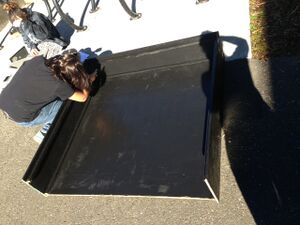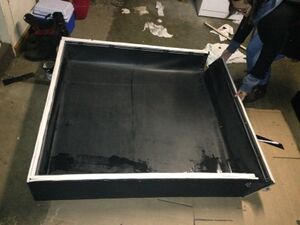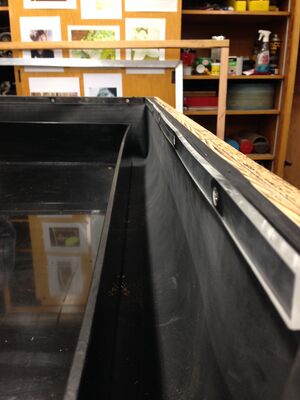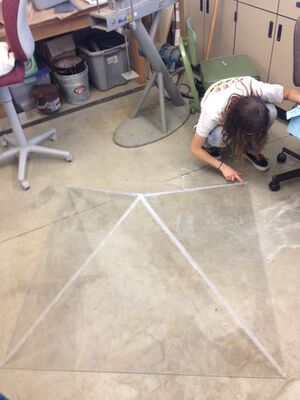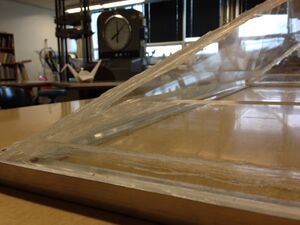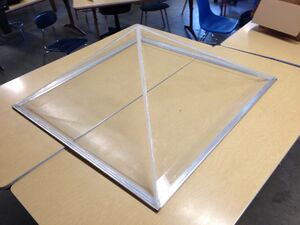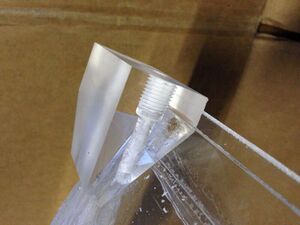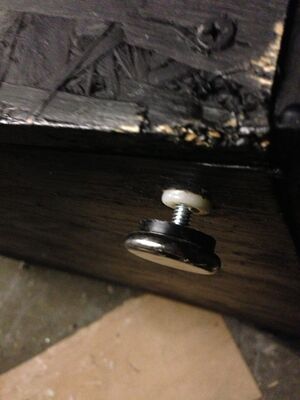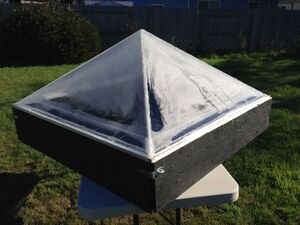
It's Always Sunny worked with Mary Mattingly, an artist based in New York City. She is collaborating with Live Arts/Fringe to design the WetLand project. Our objective is to design a long lasting desalination system that produces distilled water from the Delaware River for the inhabitants of the barge. The desalination system will promote sustainability through inspirational design and compliment the overall theme of the barge.
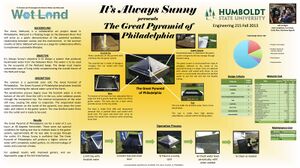
It's Always Sunny's solution and final design is a pyramidal solar still called The Great Pyramid of Philadelphia. This still desalinates brackish water from the Delaware River and turns it into freshwater, as shown in Figure 1
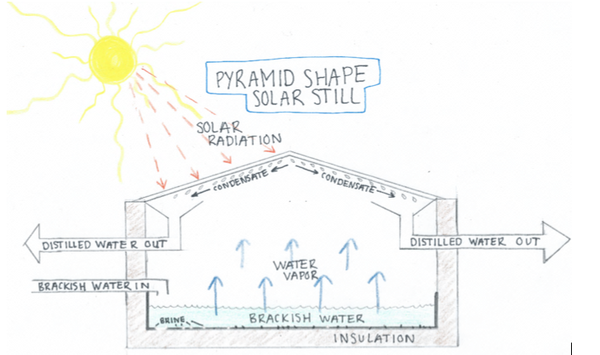
Criteria[edit | edit source]
The table below shows the client criteria for our project. The criteria is organized by it's relative weight of importance on a scale of 0-10, with 10 being the high.
| Weight | Criteria | Definition |
|---|---|---|
| 10 | Functionality | The ability for the final solution to perform at the level that the
client expects. |
| 10 | Feasibility | The practicality of the design and the probability of successful construction. |
| 9 | Safety | The product of the solution will not pose any health risks to the consumers. |
| 9 | Level of Inspiration/Educational Value | Through innovative and creative design, the solution will inspire and influence the public to consider new ways of living sustainability. |
| 8 | Cost | Through testing, purchasing materials, and building, the solution cannot exceed the allocated budget. |
| 7 | Aesthetics | The final solution will be visually pleasing to the public and attractive by design. The style of the solution should complement the artistic style of the entire WetLand barge |
| 6 | Ease of Use | The difficulty level of the operation and maintenance of the solution. |
| 4 | Maintainability | The solution will be convenient to access and will require a small amount of daily maintenance. |
| 3 | Reproducibility | The ease of the solution to be replicated by someone without technical experience. |
Description of Final Design[edit | edit source]
The Great Pyramid of Philadelphia is a pyramidal shaped solar still, shown in Figure 2, that produces desalinated water from brackish water. The Great Pyramid of Philadelphia consists of three main components; the pyramid top, the gutter system, and the base.
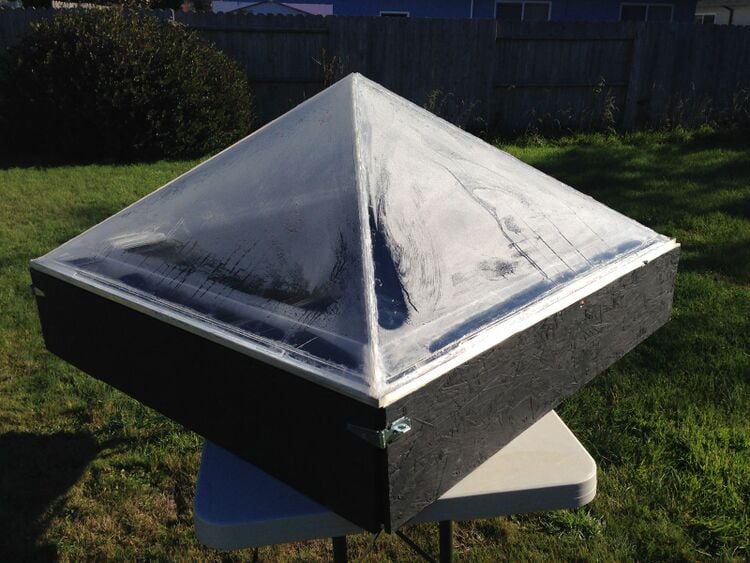
Pyramid Top[edit | edit source]
The top of The Great Pyramid of Philadelphia is a pyramid made of plexiglass, as shown in Figure 3. The sides are sealed with food grade silicon, which will not add any contaminants to the clean water that will condensate on the inside of the pyramid. At the base of the pyramid, an aluminum square base keeps the pyramid rigid and in place.
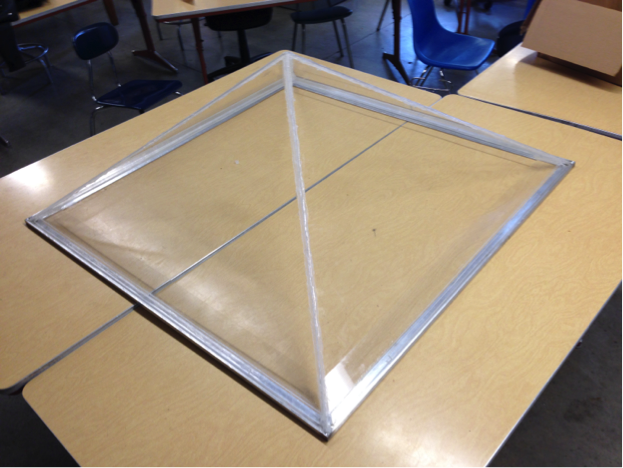
Gutter System[edit | edit source]
The gutter system of the Great Pyramid of Philadelphia is made from plexiglass strips adhered to the bottom of the pyramid top at an angle to form a V shape, as shown in Figure 4. The condensed water that runs down the sides of the pyramid is collected in the V-shaped gutters. At one corner of the pyramid is an outlet that pipes out the desalinated water into storage, as shown in Figure 5. The outlet is made of plexiglass and adhered to the outside of the pyramid, and the tubing to pipe out the clean water is made of polyethylene, a safe plastic for drinking water. After the water is piped out, it will run through a carbon filter before being stored.
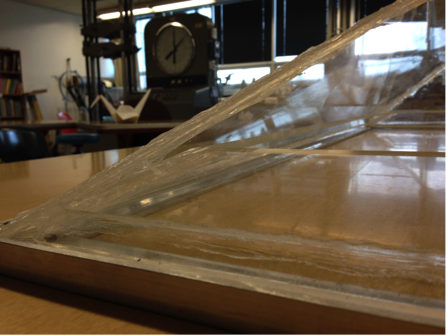
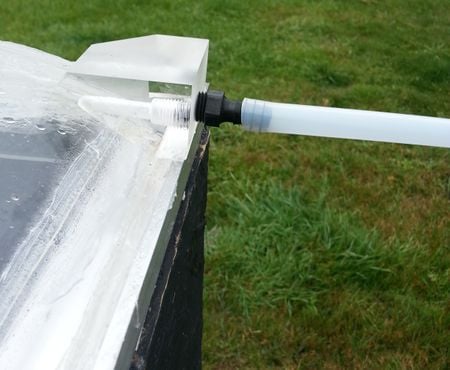
Base and Tray[edit | edit source]
The base of The Great Pyramid of Philadelphia is made of plywood and supports the pyramid top. The base is painted black and lined with pond liner, as shown in Figure 6, to seal and protect the wood from moisture. The pond liner is attached to the base with strips of plexiglass and stainless steel screws, as shown in Figure 6. One of the sides of the base is a door, allowing access to the inside of the base. Inside the base is a black high density PVC tray, as shown in Figure 6. The brackish water will be put directly into the tray for the desalination process. On the bottom of the base are adjustable feet that allow the user to position the still so the outlet on the pyramid is the lowest point, enabling the water to easily flow out.
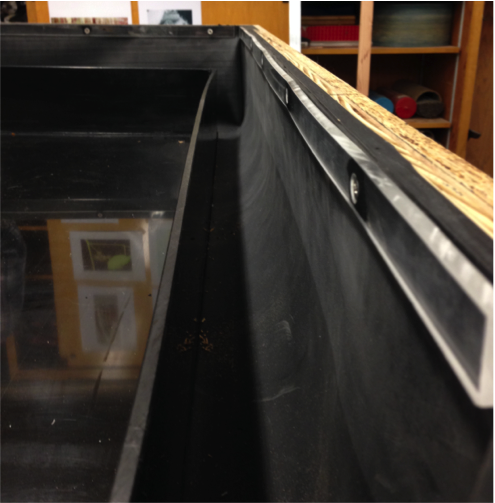
Costs[edit | edit source]
The sortable table below shows the cost and quantity of the materials we used to build our solar still.
| Item | Quantity | Team Cost ($) | Retail Cost ($) |
|---|---|---|---|
| Duct Tape | 1 | 6.99 | 6.99 |
| Masking Tape | 1 | 7.99 | 7.99 |
| Gorilla Tape | 1 | 8.99 | 8.99 |
| Wood Glue | 1 | 9.89 | 9.89 |
| 7'16" OSB 4'x8' Sheet | 1 | 15.09 | 15.09 |
| 3/4" Plywood 4'x8' | 1 | DONATED | 30.90 |
| Acrylic Sheeting | 1 | DONATED | 98.00 |
| Hinge 1"x12" | 1 | 5.39 | 5.39 |
| Hinge 1"x12" | 1 | 5.39 | 5.39 |
| Flat Black Paint 1/2 Pint | 1 | 12.04 | 12.09 |
| Paint Brushes | 3 | 5.37 | 5.37 |
| Silicone | 4 | 27.96 | 6.99 |
| Water Tray | 1 | DONATED | 300.00 |
| Total Cost | $94.34 | $506.74 | |
This pie chart shows the hours spent throughout our project.
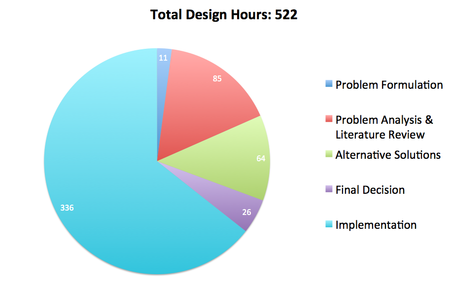
Testing Results[edit | edit source]
The Great Pyramid of Philadelphia ran for a total of 5 sun hours at 40 degrees Fahrenheit. These were not optimal conditions for testing and due to multiple leaks in the gutter system, approximately 30 mL was able to escape through the outlet. It's Always Sunny is confident that The Great Pyramid of Philadelphia will produce a higher volume of water with completely sealed gutters, no internal leakage of water, and a warmer climate.
More information to come.
How to build[edit | edit source]
Step-by-step instructions of how to replicate our solar still are shown below.
Attach weatherproofing strips to the top of base and rest pyramid on top of it, sealing the interior from the exterior.
Team Video[edit | edit source]
Suggestions & Recommendations for Similar Projects[edit | edit source]
- It's Always Sunny suggests exploring other alternate designs other than a pyramid due to the multiple building difficulties we encountered; a single slant solar still is recommended.
- The v-shaped gutter system proved to be more difficult to seal than we expected and we recommend trying different styles of gutters; for a single slant solar still we suggest exploring a PVC pipe gutter system, for a pyramidal solar still we recommend experimenting with a gutter system attached to the bottom of the pyramidal top.
- Having a securely sealed, closed system is very important for the efficiency of a solar still. We recommend sealing the top of the still to the base instead of using weather stripping.
- Due to many complications that arose while building such a large project, we highly recommend building a much smaller solar still.
- We suggest experimenting with different designs of the still that have different ways of accessing the tray other than a door on the base.
